Pasta is just about my favorite food group, lol. So I’ve been wondering just how much better it might be if I made it myself.
Actually, I had planned to try making homemade pasta many years ago. I even got an Atlas pasta machine like my friend Dawn Brocco shows in her blog article here. But then I decided to use the Atlas pasta machine for clay crafting (especially buttons to go with hand-knitted sweaters). Obviously, once I had used the pasta machine for non-food, I was never going to chance using it for food prep.
Recently I purchased an Omega Juicer with of course, the idea of using it for a juicer. It’s GREAT at juicing. But I also read that it could be used for extruding pasta. So I decided to try it out for making some pasta. There are several nozzles available that come with the Omega. The one I decided to play with is for thin, round spaghetti.
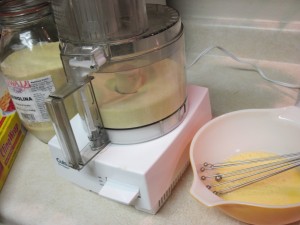
Preparing the Pasta Dough
I used a Cuisinart Pro Classic Food Processor fitted with the plastic blade to speed up the kneading process (and also to save my hands for knitting, ha! ha!). But of course you could also hand-mix and knead the dough.
1. Bring the following ingredients to room temperature before beginning:
300 g semolina flour
1 tsp salt
3 large eggs beaten
2. In the food processor, pulse the flour and salt a couple of times to mix these ingredients well.
3. While the processor is running, dribble the whipped eggs through the feed tube a little at a time until all has been added.
4. Continue processing until the ingredients form a smooth ball of elastic dough.
5. Set out the dough on a work surface lightly dusted with all purpose flour. Knead a few times by hand again just to feel like you are working so hard at this, ha! ha!
6. Shape the dough into a ball and put it in a covered bowl. Leave to dough to rest for 15 – 20 minutes while setting up the work area for extruding the pasta and taking a break to take a few sips of wine.
Sorry, no photos of the steps for the dough itself. I completely forgot about that while listening to the food processor chug away (it did get quite noisy as the dough came together).
Extruding the Spaghetti Pasta
And no photos of the actually extruding the dough with the Omega (that goes so fast that one could use more hands, lol). I promise that next time I do this, I will try to get pictures.
I handled only about 1/4 of the dough at a time as you don’t want it to dry out. Even a 1/4 of that ball of dough makes a lot of spaghetti.
I set up a clean kitchen towel lightly dusted with all purpose flour under the nozzle of the Omega. I also filled a large-holed shaker with some more all purpose flour. Using one hand, I pushed the dough down with the plunger into the feed tube of the Omega while dusting the spaghetti coming out of the nozzle. The nozzle has 4 holes; it is important to dust well enough so that the strands of spaghetti do not stick together at this stage. This goes REALLY fast and before the strands get too long, turn machine off and cut the strands off at the nozzle. Then separate the strands and hang on a rack to dry.
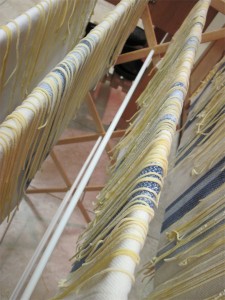
Drying the Spaghetti Pasta
That rack I used is just one of those cheap clothes-drying racks. The towels are cotton I hand-wove in the Acadian style thanks to a workshop from Norman Kennedy a number of years ago. Love those towels, and they look nice with the pasta too, don’t you think? It could almost be fiber art!
The spaghetti is a little messy looking, but toward the end I was getting better with the process. Next time should be easier. I also imagine that if I had started out with one of the nozzles with thicker holes (e.g. fettucini), it might not have been quite as tedious.
I left the spaghetti to dry over night and then removed it from the rack. I was so anxious to see how it tasted that I didn’t even bother to put it into a storage container. Next step is straight to the cooking pot.
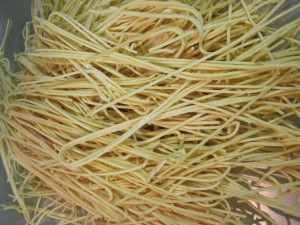
Cooking the Spaghetti
Be prepared that fresh pasta is going to cook in a fraction of the time of commercial off-the-shelf pasta. You actually don’t even really have to taste-test it to know … you can see its “doneness” when it is floating on top of the water and sort of puffs up and gets a bit translucent. Perfect al dente.
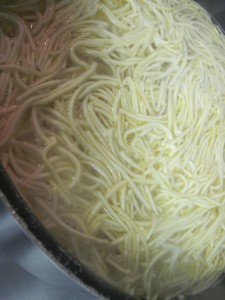
Drain the spaghetti and its ready to eat. At this stage, I guess it doesn’t really look a whole lot different than regular store-bought spaghetti. But we know differently, don’t we?
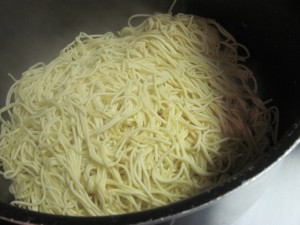
Eat and Enjoy
Meantime, John had been making a meat sauce ragu to serve with the spaghetti. I wasn’t really watching closely, so don’t ask me too much about it. I just know that between the fresh pasta and the meat sauce, I think this is the yummiest spaghetti I have ever had.
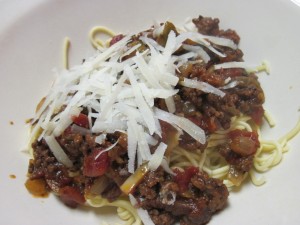
We both agreed that the fresh spaghetti pasta was a success. Maybe more work than we are willing to routinely do. But its definitely worth the trouble for a special treat. I would make spaghetti again. And want to try making fettucini sometime, too.
Do you have some experience with making pasta you would like to share? I could certainly use tips now that I am hyped for making more fresh pasta.
p.s. I also wrote about using the Omega Juicer in Is It Corny to Grind Your Own Corn. I’m certainly getting a lot more use out of this Omega Juicer than just juicing!
